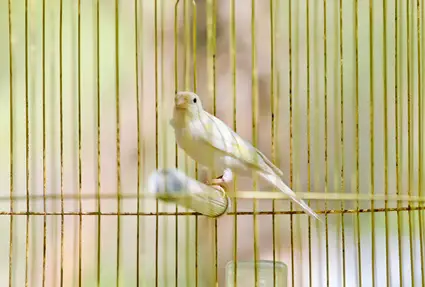Pet canaries live for around 10-15 years. To raise the chances of a captive canary living this long, provide a well-optimized living environment, meet its care needs, and be vigilant about sickness and diseases.
Wild canaries don’t live as long as captive canaries because they face more dangers. Wild birds face the threat of predatory animals, extreme weather (hot and cold), and the destruction of their habitats.
How Many Years Do Canaries Live in Captivity?
This table specifies the average lifespan of different types of domesticated canaries:
| Breed of Canary | Average Lifespan |
| American Singer Canary | 10 – 15 years |
| Belgian Fancy Canary | 10 – 15 years |
| Border Fancy Canary | 10 – 15 years |
| Crested Canary | 10 – 15 years |
| Fife Fancy Canary | 6 – 10 years |
| Frilled Canary | Up to 10 years |
| Gloster Canary | 7 – 12 years |
| Lancashire Canary | 10 – 15 years |
| Lizard Canary | Up to 10 years |
| Norwich Canary | 10 – 15 years |
| Scotch Fancy Canary | 10 – 15 years |
| Stafford Canary | 10 – 15 years |
| Yorkshire Canary | 10 – 15 years |
A female canary lifespan is often shorter than a male, especially if you breed them.
These are always averages and estimates, as any canary can fall ill unexpectedly. Always check for signs of unhappiness and ill health, such as stress, seizures, mites, pox virus, and respiratory conditions.
How Long Do Canaries Live in the Wild?
Most wild canaries don’t live to see their 10th birthday, primarily due to the risks found in nature.
Canaries are pretty adaptable, typically surviving well in different habitats. However, global deforestation makes it harder for birds of all species to survive and thrive.
Wild canaries are likely to eat well, eating wheat, berries, small insects, and fruits to sustain themselves.
Alas, the size of canaries means they’re low on nature’s food chain. Larger birds, especially crows and falcons, regularly pick off canaries. Snakes are also a familiar foe.
According to Comparative Biochemistry and Physiology, canaries grow quickly, reaching their adult size within 10 days. However, escaping by flying away is a canary’s most effective defense.
Would a Captive Canary Survive in the Wild?
If you have kept a pet canary in a cage, this bird must never be released into the wild.
A canary hatched and raised as a pet will lack the survival skills to forage for food, stay warm, and avoid dangerous predators. Unfortunately, a pet canary is unlikely to survive more than a few days.
What’s the Oldest Canary Bird?
The Guinness World Record for a canary’s lifespan is 34 years. A captive canary in Nigeria named Joey enjoyed this long life, hatching in 1941 and eventually dying in 1975.
How To Help A Canary Live Longer
Many factors affect a canary’s lifespan in captivity. If you’re keen to ensure the canary lives as long as possible, abide by these guidelines:
Appropriate Diet
While most owners start with a seed-based diet, pellets are more nutritious.
You can still feed mixed seeds occasionally, but these should not be the cornerstone of a canary’s diet. One teaspoon per day, alongside other foods, is more than enough.
Tropical fruits are favored by canaries, so add them to the canary’s diet in moderation.
Strawberries, mangoes, pears, grapes, and peaches will be devoured with gusto, providing your canary with much-needed vitamins, minerals, fiber, and antioxidants to fight oxidative stress.
Fresh vegetables can also be offered, but anything high in water, like cucumber or lettuce, can cause gastric upset. As per the Journal of the American Veterinary Medical Association, avocado is toxic to birds.
Balance is vital when feeding a canary. Birds need a blend of vitamins and minerals, especially calcium and protein. Pellets make a great baseline as long as they’re supplemented with other nutritious foods.

Exercise
Canaries are active and energetic birds that love to fly. Because they hop from perch to perch, you’ll need a large cage to accommodate them.
You must also provide plenty of opportunities to fly and exercise outside the cage.
This exercise will bolster a canary’s health, especially heart health and stress reduction. It’ll also leave a canary exhausted, ensuring it sleeps well overnight.
You must make the home safe for a canary to fly free.
Remove other pets from the canary’s territory, especially those with a high prey drive that would chase or attack your bird. Cover windows and doors so the canary doesn’t fly into them.
Lack of Stress
Canaries can be easily stressed, which places their health at risk. Placing excessive strain on a canary’s heart can lead to cardiac arrest. You need to understand the signs that a canary is stressed:
- Increased vocalization
- Excessive feather picking
- Changes in appetite
- Sleep disturbances
- Aggression
- Decreased activity levels
- Unusual posture
- Self-mutilation
- Feather ruffling
- Changes in droppings
Stress must be managed before it takes hold and becomes a default emotion. Ideally, avoid circumstances that could stress a canary in the first place. Common triggers include:
- Small, cramped cages.
- Excessive stimulation, especially bright lights and loud noises.
- Lack of sleep.
- Boredom due to a lack of in-cage entertainment and interaction with owners.
- Presence of other potentially predatory pets (especially cats.)
- Excessive handling.
- Unsanitary living conditions.
Avoid forcing canaries to live together. Canaries are very territorial, especially in smaller, confined spaces, so two birds will likely find it distressing to share the same cage.
Health Checks
Once registered with a vet, take the canary for check-ups at least once a year. This will help stave off concerns about illnesses and diseases that can impact canaries, which include:
- Eye problems.
- Foot concerns, such as plantar pododermatitis (commonly known as “bumblefoot.”)
- Misalignment in the beak.
- Arthritis.
- Atherosclerosis (also known as coronary artery disease.)
While not all of these conditions are life-threatening, their impact on a canary’s quality of life may shorten its lifespan significantly.
You’ll also need a reliable vet if a canary experiences a medical emergency, including trauma from an injury or a sudden seizure. Canaries are reluctant to show obvious signs of ill health.
If you wait for a canary to make it obvious it’s suffering, damage may already have been done. Regular health checks will identify any warnings of symptoms before they become a concern.
Avoid Breeding
The lifespan of females is often cut short if they’re part of a breeding program. If a female canary lays eggs more than once, her life expectancy will significantly reduce.
Canaries can live up to 15 years if you take appropriate care of the bird and retain its happiness and contentment throughout its lifespan.








